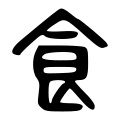| 食 | ||
|---|---|---|
| ||
| 食 (U+98DF) "eat, food" | ||
| Pronunciations | ||
| Pinyin: | shí | |
| Bopomofo: | ㄕˊ | |
| Wade–Giles: | shi2 | |
| Cantonese Yale: | sik6 | |
| Jyutping: | sik6 | |
| Japanese Kana: | ショク shoku (
on'yomi) く-う ku-u / た-べる ta-beru ( kun'yomi) | |
| Sino-Korean: | 식 sik | |
| Hán-Việt: | thực, tự | |
| Names | ||
| Chinese name(s): | (Left) 食字旁 shízìpáng (Bottom) 食字底 shízì | |
| Japanese name(s): | 食/しょく shoku (Left) 食偏/しょくへん shokuhen | |
| Hangul: | 밥 bap | |
| Stroke order animation | ||
 | ||


Radical 184 or radical eat (食部) meaning " eat" or " food" is one of the 11 Kangxi radicals (214 radicals in total) composed of 9 strokes.
In the Kangxi Dictionary, there are 403 characters (out of 49,030) to be found under this radical.
食 is also the 185th indexing component in the Table of Indexing Chinese Character Components predominantly adopted by Simplified Chinese dictionaries published in mainland China, with the simplified left component form 饣 and its traditional form 飠 listed as its associated indexing components.
Evolution
-
Oracle bone script character
-
Bronze script character
-
Large seal script character
-
Small seal script character
Derived characters
| Strokes | Characters (食飠) | Characters (饣) |
|---|---|---|
| +0 | 食 飠Component | 饣SC component (=飠) |
| +2 | 飡 (=餐) 飢 飣 飤 (=飼) | 饤SC (=飣) 饥SC (=飢) |
| +3 | 飥 飦 飧 飨SC (=饗) | 饦SC (=飥) 饧SC (=餳) |
| +4 | 飩 飪 飫 飬 飭 飮 (=飲) 飯 飰 (=飯) 飱 (=飧) 飲 | 饨SC (=飩) 饩SC (=餼) 饪SC (=飪) 饫SC (=飫) 饬SC (=飭) 饭SC (=飯) 饮SC (=飲) |
| +5 | 飳 飴 飵 飶 飷 飸 (=饕) 飹 飻 飼 飽 飾 飿 | 饯SC (=餞) 饰SC (=飾) 饱SC (=飽) 饲SC (=飼) 饳SC (=飿) 饴SC (=飴) |
| +6 | 飺 餀 餁 (=飪) 餂 餃 餄 餅 餆 餇 餈 (= 糍 -> 米) 餉 養 餋 餌 餍SC (=饜) 餎 餏 | 饵SC (=餌) 饶SC (=饒) 饷SC (=餉) 饸SC (=餄) 饹SC (=餎) 饺SC (=餃) 饻SC (=餏) 饼SC (=餅) |
| +7 | 餐 餑 餒 餓 餔 餕 餖 餗 餘 餙 餝 | 饽SC (=餑) 饾SC (=餖) 饿SC (=餓) 馀SC (=餘) 馁SC (=餒) 馂SC (=餕) |
| +8 | 餚 餛 餜 餞 餟 餠 (=餅) 餡 餢 餣 餤 餥 餦 餧 (=餵) 館 餩 | 馃SC (=餜) 馄SC (=餛) 馅SC (=餡) 馆SC (=館) |
| +9 | 餪 餫 餬 (= 糊 -> 米) 餭 餮 餯 餰 餱 餲 餳 餴 餵 餷 | 馇SC (=餷) 馈SC (=饋) 馊SC (=餿) 馋SC (=饞) |
| +10 | 餶 餸 餹 (= 糖 -> 米) 餺 餻 (= 糕 -> 米) 餼 餽 餾 餿 饀 饁 饂 饃 | 馉SC (=餶) 馌SC (=饁) 馍SC (=饃) 馎SC (=餺) 馏SC (=餾) 馐SC (=饈) |
| +11 | 饄 (= 糖 -> 米) 饅 饆 饇 饈 饉 | 馑SC (=饉) 馒SC (=饅) |
| +12 | 饊 饋 饌 饍 (= 膳 -> 肉) 饎 饏 饐 饑 饒 饓 | 馓SC (=饊) 馔SC (=饌) |
| +13 | 饔 饕 饖 饗 饘 饙 | |
| +14 | 饚 饛 饜 | |
| +16 | 饝 (=饃) | |
| +17 | 饞 饟 (=餉) | |
| +19 | 饠 饡 | |
| +22 | 饢 | 馕SC (=饢) |
Variant forms
This radical character has different forms in different languages when used as an individual character and as a component.
Traditionally, when used as an individual character, its third stroke is printed as either a horizontal line (食) or a vertical line (食), but more often written as a slanted dot (食); when used as a left component, it is usually printed as 𩙿 and written as 飠 in regular script.
In China, xin zixing adopted the handwritten form 食 and 飠 and applies it also to printing typefaces. This change is applied chiefly to Traditional Chinese publications in mainland China; the left component form 飠 was already replaced by the simplified form 饣 prior to the printing typeface reform. Taiwan's Standard Form of National Characters and Hong Kong's List of Graphemes of Commonly-Used Chinese Characters use 食 and 飠 (the third stroke is horizontal) as the standard forms, while other alternative forms (e.g. 食/𩙿, 食/飠) are still rather prevalent in publishing.
In modern Japanese, 食 (third stroke is horizontal) and 𩙿 are seen as the traditional/orthodox forms. The shinjitai reform changed the third stroke in 食 as an individual character or as a non-left component to a short horizontal line (食); changed the left component form 𩙿 to 飠. In principle, these changes apply only to jōyō kanji (more specifically, jōyō kanji before 2010 revision; some characters added in 2010 were not simplified); the traditional form is used for hyōgai kanji.
| Kangxi Dict. Korean |
Japanese | Trad. Chinese (TW, HK, MO) |
Trad. Chinese (Mainland China) |
Simp. Chinese |
|---|---|---|---|---|
| 食 | 食 | 食 | 食 | 食 |
| 飼 | 飼 | 飼 | 飼 | 饲 |
| 饉 | 饉 | 饉 | 饉 | 馑 |
| 饕 | 饕 | 饕 | 饕 | 饕 |
Literature
- Fazzioli, Edoardo (1987). Chinese calligraphy : from pictograph to ideogram : the history of 214 essential Chinese/Japanese characters. calligraphy by Rebecca Hon Ko. New York: Abbeville Press. ISBN 0-89659-774-1.



